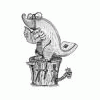The hammer is the easy scenario, the adze a little more challenging.
There is, of course, a relationship between the finished eye and the initial slot punch.
I punch from 1 side up to 1 inch thick or two sides for over 1 inch.
If I am working at the anvil, I forge out the desired ends of the hammers before drifting the eye. If I am working at the power hammer, I continue to drift and spread the eye before forging the ends out.
In spreading the eye, the eye is elongated and distorted as shown in the photographs.
I have a second drift that I apply from each side to form the hour-glass shape to the inside of the eye to prevent the handle from flying off.
I'm afraid that I do not have an adze progression of photographs.
The difference for me is to fuller in from the bottom of the adze to start shaping the ends. In this way the top side of the adze remains flat.
You can either drift with a parallel drift and work the eye or you can drift with a tapered drift from the top and work the eye.
You might find it useful to drift over the vice jaws for support of the adze-eye edges.

